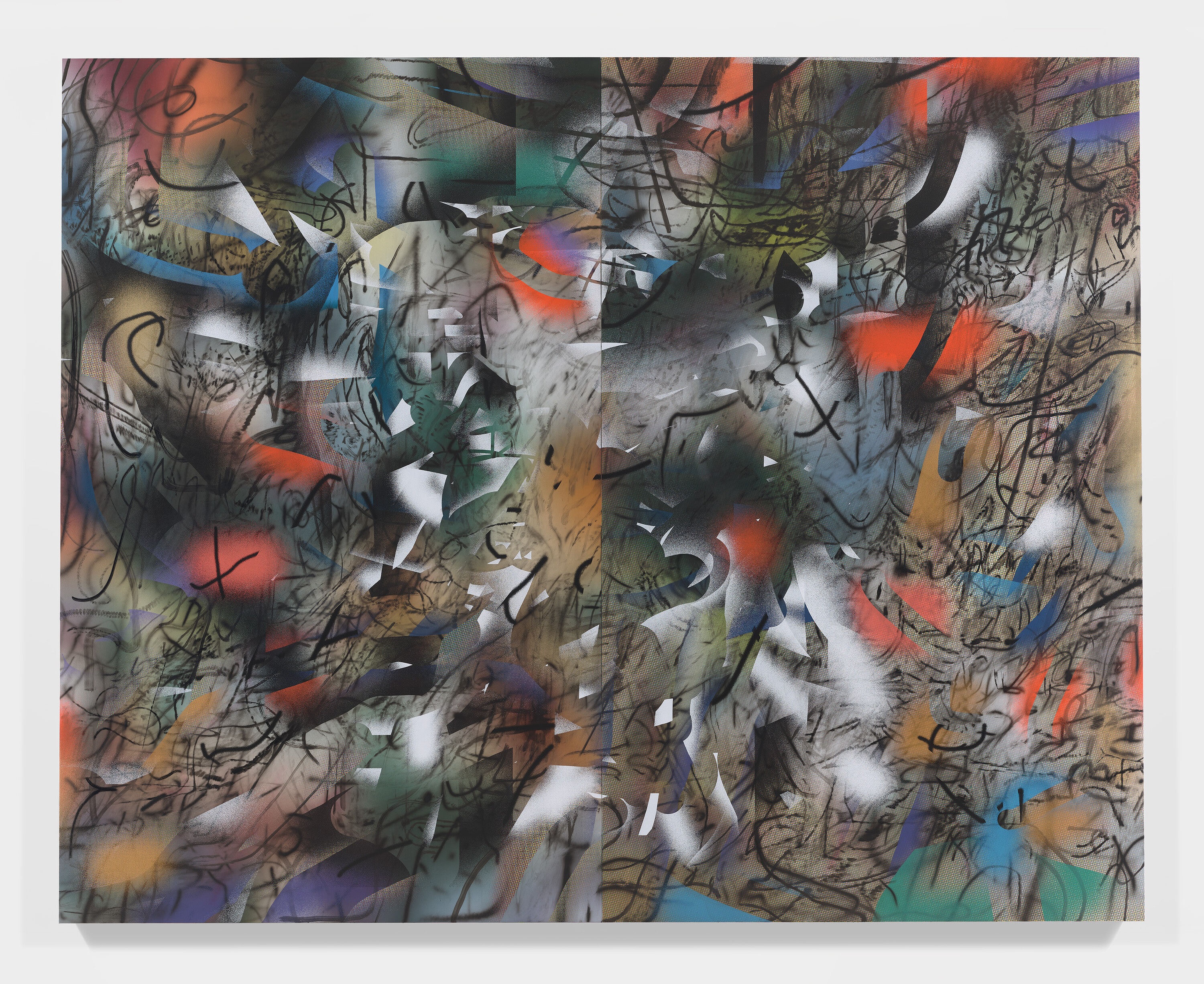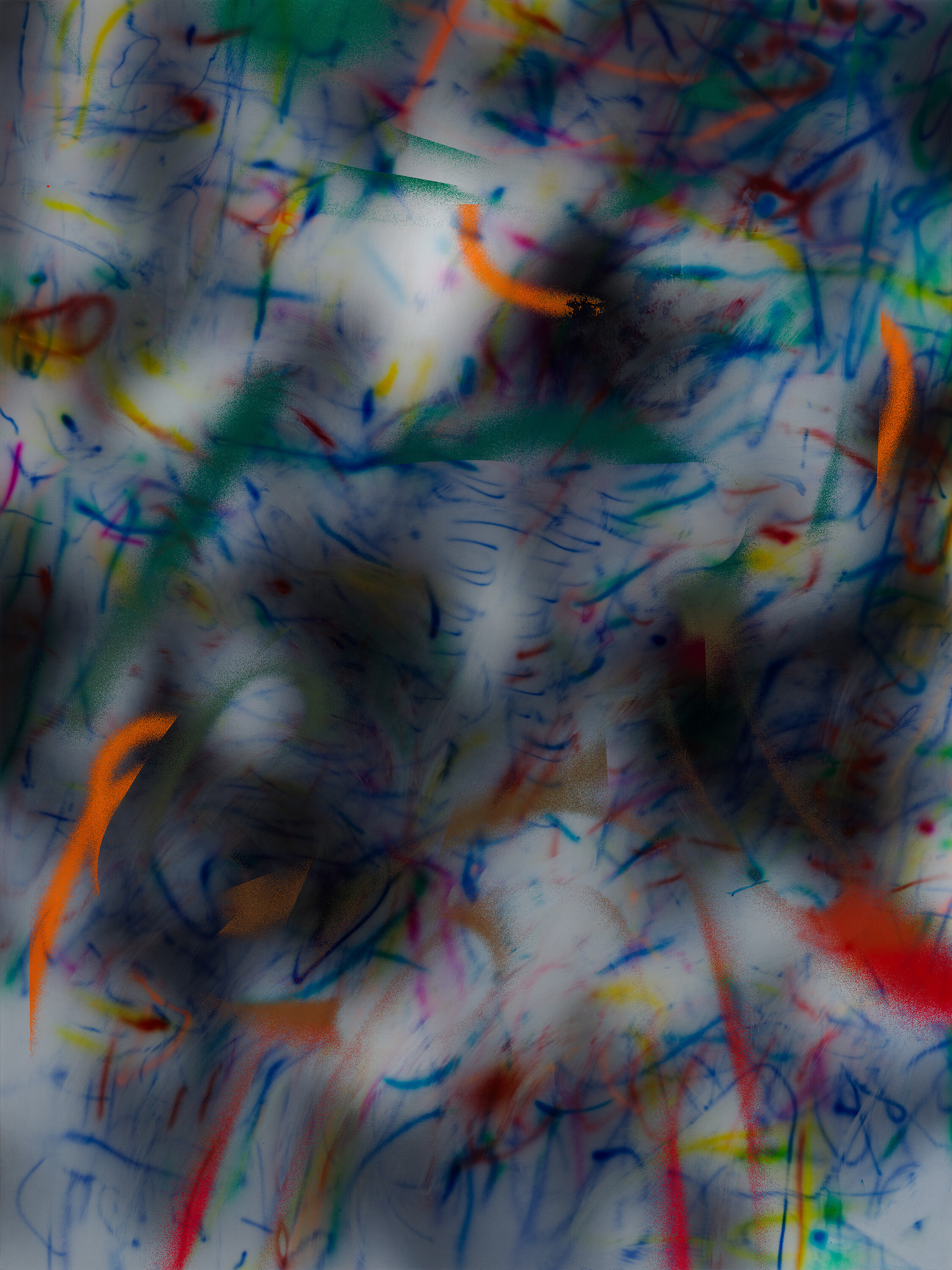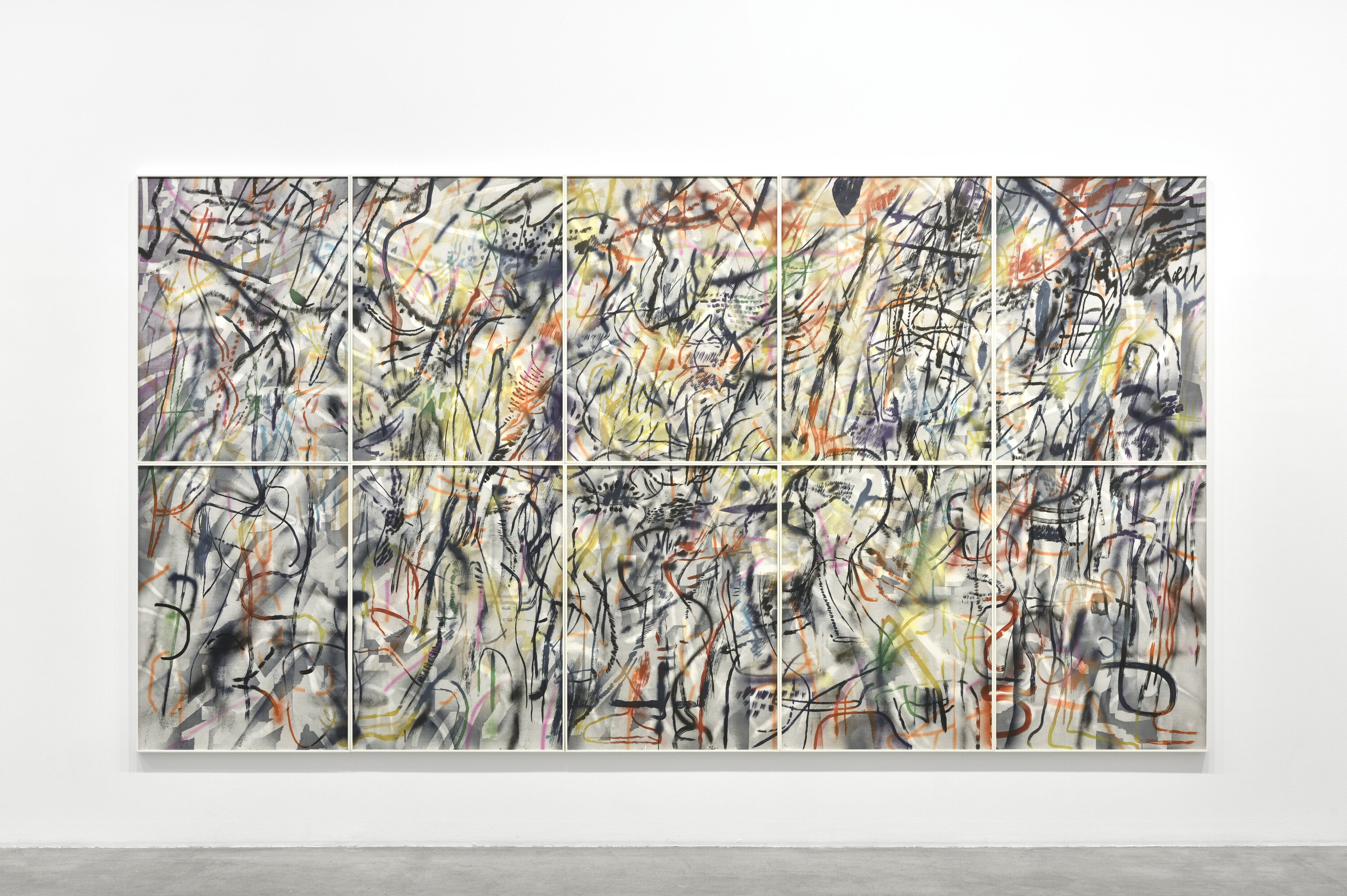Julie Mehretu, about the space of half an hour (R. 8:1) 5, 2019–2020, ink and acrylic on canvas. Image courtesy and © Julie Mehretu, photograph: Tom Powel Imaging
Julie Mehretu: A Transcore of the Radical Imaginatory
Brian Obiri-Asare
We first met in the pages of NKA in a tribute issue honouring Okwui Enwezor. Julie Mehretu shared an anecdote: during a visit to her Harlem studio, Enwezor waxed lyrical about her paintings, and how they interrogated the colonial sublime. After a quick Google search, I discovered Dispersion (2002). I was immediately enchanted. An other-worldly image—suggestive of maps, contour lines, and geometric forms—strewn with a cacophony of colour and spun in a spiralling black presence. It drew me in and simultaneously drew dislocation out. The image was more than just a surface. Way back then, it articulated something I’ve always felt growing up inside and outside of things, living in different continents, cities, outback towns, between languages and customs. I also discovered that Julie worked in the trenches of radical political yearning. She deliberately drew from this wellspring, but her efforts centred on questioning, on taking its myths apart.
These days, these trenches are losing their fire. A jaded cynicism smoulders. The pairing of art with the word “radical” often induces a rolling of the eyes. Many have had enough of the endless posturing, full of sound and fury. That’s because they often don’t bear any interesting fruit. The art produced under this lucrative sign can be tediously incoherent, shriekingly puritanical or hideously decadent, but more often than not, it’s just a bit too much. Especially when all you want to do is enjoy the fruits of an artist’s struggle towards expression, her attempt at articulating something beautiful, touching or otherwise engaging.
On this note, Mehretu doesn’t disappoint. She has something to say and always does her viewers the honour of treating them as intelligent human beings. And despite the seductions of prestige, of becoming an art world darling, a rare binary star—popular and avant-garde, a BMW collaborator—she has remained faithful to her radical trenches. A fire still burns. Abstraction is her métier, and within its expansive language, she revels in opacity. It affords her a certain freedom—a vehicle—to explore beyond the sweet seductions of the blindingly clear places of imagination and inspiration that insist on something and somewhere else. She also makes space for, engages with, and celebrates the black radical tradition. From Fred Moten, Hortense Spillers, Jack Whitten, and David Hammons to Toni Morrison and many more, she’s in constant conversation with those who’ve come before her. Indeed, the long history of radical black artists working within abstraction, whether artistically, musically, or intellectually, exerts a determinative influence on how Mehretu goes about her business—and offers a bedrock for the language she uses to conceptualise what she does.

Julie Mehretu, Haka (and Riot), 2019, ink and acrylic on canvas. Image courtesy and © Julie Mehretu, photograph: Tom Powel Imaging
Seeing how these predilections and predispositions translated into the Australian context got me curious about Julie Mehretu: A Transcore of the Radical Imaginatory at the MCA. I was open to abstraction’s power as a vehicle, its inheritance of black radicalism, and its capacity to give form to our collective experience. I was willing to be a believer. I was open to unexpected revelations. But mainly wanted to be stirred like I had when I first discovered her.
Initially, I was disappointed. Climbing up the stairs to the third floor of the MCA, filled with expectation, I was greeted with flatness. Stepping into the exhibition, I first set my eyes on colour, a storm of it, in lines and squiggles, but there was so much going on on the surface, not enough depth, not enough space to breathe. To my right were Mehretu’s Mind Breath Drawings (2010), three monologues of smeared, smudged, sometimes incisive, and sometimes lapidary, graphite on paper that complimented the initial overwhelm of colour. They set up the visual motifs that reappear in various guises throughout the exhibition. The disappointment lifted when I found myself in a darkened room where a documentary, Julie Mehretu: Palimpsest, played out on a loop, building the narrative arc of a life devoted to painting, drawing, printmaking, and thinking about the world. Curatorially astute, this was much-needed grounding before a dance with abstraction.

Julie Mehretu, about the space of half an hour (R. 8:1) 5, 2019–2020, ink and acrylic on canvas. Image courtesy and © Julie Mehretu, photograph: Tom Powel Imaging
Emerging from this darkened room, Julie’s more recent work dominated. This work is composed of layers, fragments, smudges, and blurs. It’s a product of improvised accretion. The built space of the paintings is often the product of digital photos, often cropped, flipped, and made hazy. For example, in the series about the space of half an hour (2019–2020), Julie metabolises images of troubling events—protests in Charlottesville, California forest fires, and the devastation caused by Hurricane Irma—and metamorphoses them into spectres that attempt to give voice to the writhing chaos of the world around us. Evocative titles—Origine/Indigene (prelude) and Rise Charlottesville (2018–2019)—tickle the imagination and linger in mystery. But, even with these prods, variations on a handful of visual themes can only take one so far. A good chunk of this exhibition is too systematic, too professional, too much of the same. There’s a flatness to much of Mehretu’s later work that marks a shift from yesteryear, when Julie’s layered canvases revealed, less obscurely, someone trying to make sense of who she was in time and space. It seems there was once more depth to her visual plane. It is a shame there wasn’t more of it. Save for a handful of small pieces, mostly on paper, a curious bridge was missing between then and now. The first major survey of Mehretu’s work in these parts could’ve done with one. The documentary alone did not suffice to tell a fuller story.
Before long, I had to take a seat. My eyes needed a rest, but I had taken a seat in front of This Manifestation of Historical Restlessness (from Robin’s Intimacy) (2022). Before long, my eyes started succumbing to the incoherence, displacement, and layered currents, flowing through one another, backwards and forwards in space. Slowly but surely, I was being drawn into Mehretu’s world.

Julie Mehretu, This Manifestation of Historical Restlessness, (from Robin’s Intimacy), 2022, 10-panel etching with aquatint. Image courtesy and © Julie Mehretu, photograph: Rebecca Fanuele
I came back to the exhibition three more times. And each time, I found the exhibition equally disappointing, baffling, and brilliant. Julie doesn’t make it easy to enter her world. Although Haka (and Riot) (2019), a real maelstrom, never ceased to steal my breath. Same with the Feminine in Nine series (2022-2023), an ode of sorts to Julius Eastman. Splayed out on the wall at the end of the MCA’s third floor, catching the natural light flooding in from Circular Quay, there was something new, something charming to discover each time. And each time I visited, the impression of witnessing an idiosyncratic thinker using abstraction to feel her way through the world deepened.
While preparing and writing this review, I listened to Julius Eastman’s Vol. 1: Femenine on loop. A susurrating blend of piano, strings, vibraphones, and voices, it made Mehretu’s work make some sort of sense. Behind my eyelids, as I listened, I’d see flickers of colour, patterns, all emerging in and out of focus. It reminded me of the book Mehretu recommended in an article I chanced upon, The Mushroom at the End of the World: On the Possibility of Life in Capitalist Ruin (2015). The book centres on the matsutake mushroom, a delicacy that grows mainly in landscapes ravaged by environmental destruction. For Mehretu, this mushroom, which thrives in forests disturbed by humans, epitomises creative upheaval. Her work has a similar effect by forcing us to sit with chaos. In this sense, it’s radical. And it’s also well worth catching the show before it disappears from these shores at the end of the month.
Brian is a writer who, for the most part, lives in Sydney.